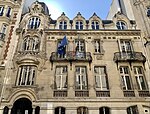American University of Paris

The American University of Paris (AUP) is a private, independent, and accredited liberal arts university in Paris, France. Founded in 1962, the university is one of the oldest American institutions of higher education in Europe, and the first to be established in France. The university campus consists of seven buildings, centrally located in the 7th arrondissement of Paris, on the Left Bank near the Eiffel Tower, Les Invalides, and the Seine.The university's language of instruction is English, although students must prove a level of proficiency in French prior to graduation. The university has over 1,100 students, representing over 100 nationalities, with an average student-to-faculty ratio of thirteen to one. The university's faculty members represent 21 nationalities, with 71% holding doctoral degrees and close to 70% speaking three or more languages.
Excerpt from the Wikipedia article American University of Paris (License: CC BY-SA 3.0, Authors, Images).American University of Paris
Avenue Bosquet, Paris 7th Arrondissement (Paris)
Geographical coordinates (GPS) Address Nearby Places Show on map
Geographical coordinates (GPS)
| Latitude | Longitude |
|---|---|
| N 48.859 ° | E 2.3037 ° |
Address
Avenue Bosquet 35
75007 Paris, 7th Arrondissement (Paris)
Ile-de-France, France
Open on Google Maps










